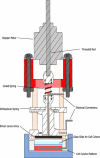The effect of injection speed and serial injection on propidium iodide entry into cultured HeLa and primary neonatal fibroblast cells using lance array nanoinjection
- PMID: 27468394
- PMCID: PMC4947087
- DOI: 10.1186/s40064-016-2757-5
The effect of injection speed and serial injection on propidium iodide entry into cultured HeLa and primary neonatal fibroblast cells using lance array nanoinjection
Abstract
Background: Although site-directed genetic engineering has greatly improved in recent years, particularly with the implementation of CRISPR-Cas9, the ability to deliver these molecular constructs to a wide variety of cell types without adverse reaction is still a challenge. One non-viral transfection method designed to address this challenge is a MEMS based biotechnology described previously as lance array nanoinjection (LAN). LAN delivery of molecular loads is based upon the combinational use of electrical manipulation of loads of interest and physical penetration of target cell membranes. This work explores an original procedural element to nanoinjection by investigating the effects of the speed of injection and also the ability to serially inject the same sample.
Results: Initial LAN experimentation demonstrated that injecting at speeds of 0.08 mm/s resulted in 99.3 % of cultured HeLa 229 cells remaining adherent to the glass slide substrate used to stage the injection process. These results were then utilized to examine whether or not target cells could be injected multiple times (1, 2, and 3 times) since the injection process was not pulling the cells off of the glass slide. Using two different current control settings (1.5 and 3.0 mA) and two different cell types (HeLa 229 cells and primary neonatal fibroblasts [BJ(ATCC(®) CRL-2522™)], treatment samples were injected with propidium iodide (PI), a cell membrane impermeable nucleic acid dye, to assess the degree of molecular load delivery. Results from the serial injection work indicate that HeLa cells treated with 3.0 mA and injected twice (×2) had the greatest mean PI uptake of 60.47 % and that neonatal fibroblasts treated with the same protocol reached mean PI uptake rates of 20.97 %.
Conclusions: Both experimental findings are particularly useful because it shows that greater molecular modification rates can be achieved by multiple, serial injections via a slower injection process.
Keywords: Injection-dose response; Lance array nanoinjection; Serial injection; Speed of injection.
Figures








Similar articles
-
CRISPR-Cas9 directed knock-out of a constitutively expressed gene using lance array nanoinjection.Springerplus. 2016 Sep 9;5(1):1521. doi: 10.1186/s40064-016-3037-0. eCollection 2016. Springerplus. 2016. PMID: 27652094 Free PMC article.
-
Electroactive nanoinjection platform for intracellular delivery and gene silencing.J Nanobiotechnology. 2023 Aug 17;21(1):273. doi: 10.1186/s12951-023-02056-1. J Nanobiotechnology. 2023. PMID: 37592297 Free PMC article.
-
Nanoinjection system for precise direct delivery of biomolecules into single cells.Lab Chip. 2019 Feb 12;19(4):580-588. doi: 10.1039/c8lc00709h. Lab Chip. 2019. PMID: 30623953
-
The mechanism of naked DNA uptake and expression.Adv Genet. 2005;54:3-20. doi: 10.1016/S0065-2660(05)54001-X. Adv Genet. 2005. PMID: 16096005 Review.
-
Dendritic cell gene therapy.Surg Oncol Clin N Am. 2002 Jul;11(3):645-60. doi: 10.1016/s1055-3207(02)00027-3. Surg Oncol Clin N Am. 2002. PMID: 12487060 Review.
Cited by
-
Transgenic expression in zebrafish embryos with an intact chorion by electroporation and microinjection.Biotechnol Rep (Amst). 2023 Oct 2;40:e00814. doi: 10.1016/j.btre.2023.e00814. eCollection 2023 Dec. Biotechnol Rep (Amst). 2023. PMID: 37840570 Free PMC article.
References
-
- Aten QT, Jensen BD, Burnett SH, Howell LL. Electrostatic accumulation and release of DNA using a micromachined lance. J Microelectromech Syst. 2011;20:1449–1461. doi: 10.1109/JMEMS.2011.2167658. - DOI
-
- Barsoum J. Animal cell electroporation and electriofusion protocols. Totowa: Humana Press; 1995.
LinkOut - more resources
Full Text Sources
Other Literature Sources
Research Materials
Miscellaneous

